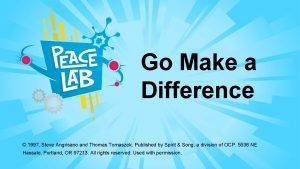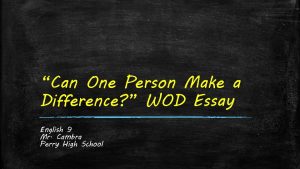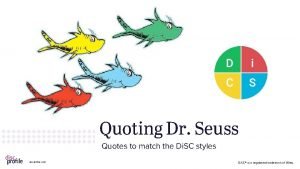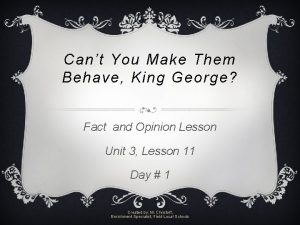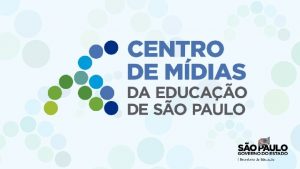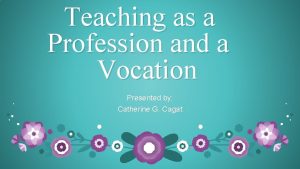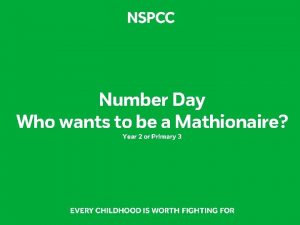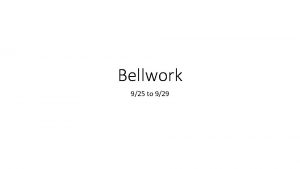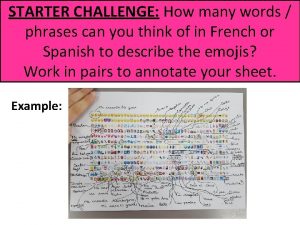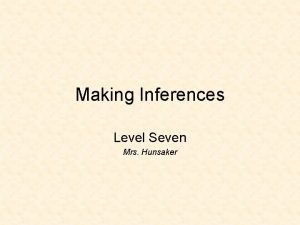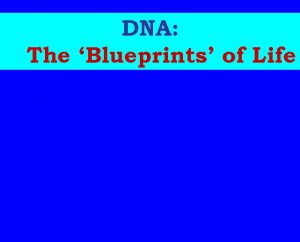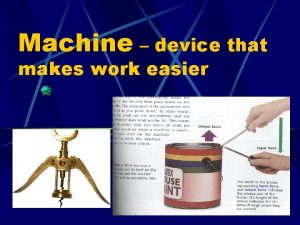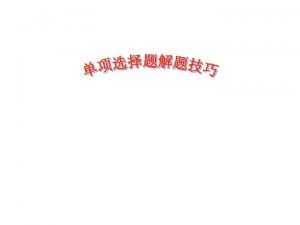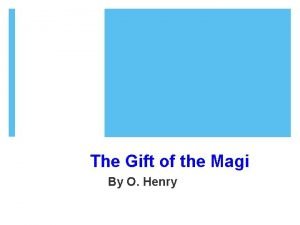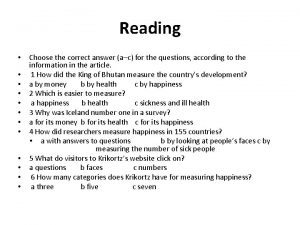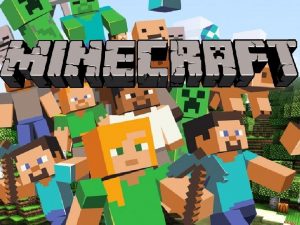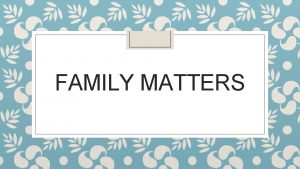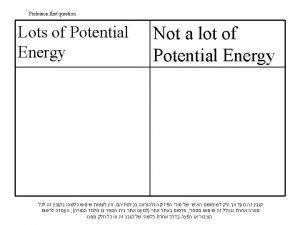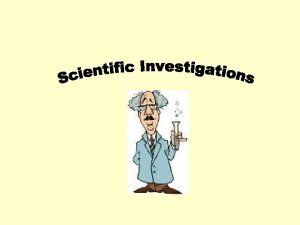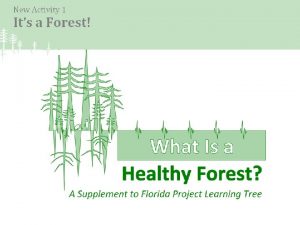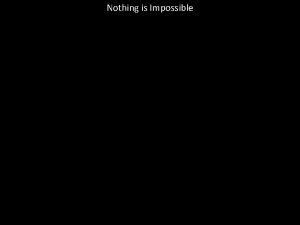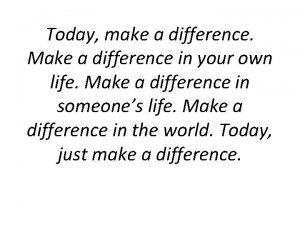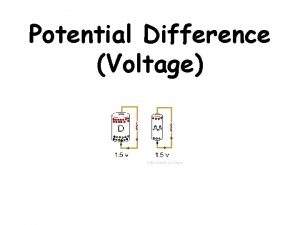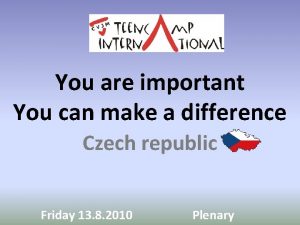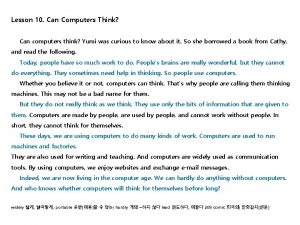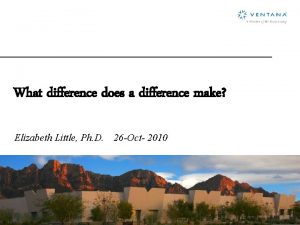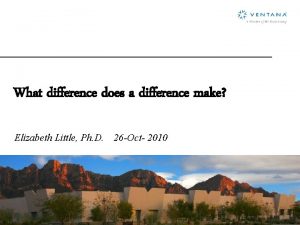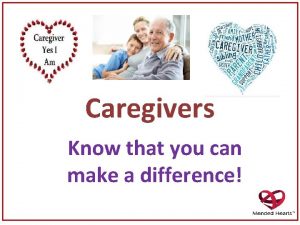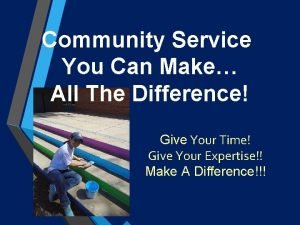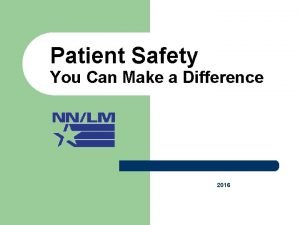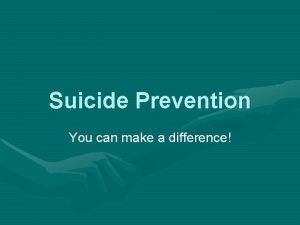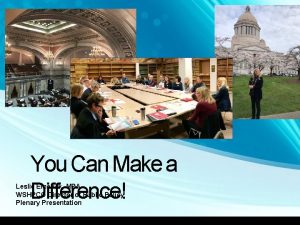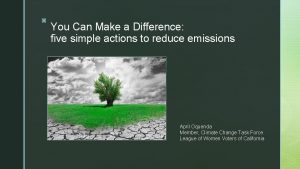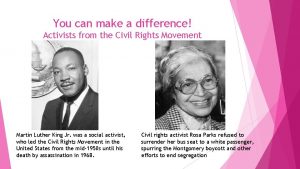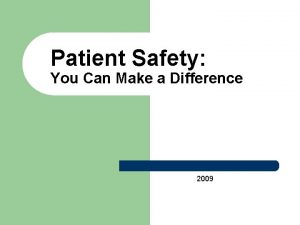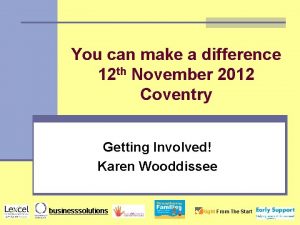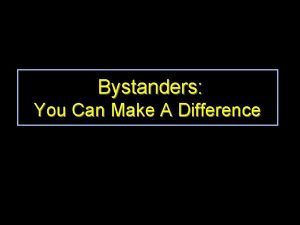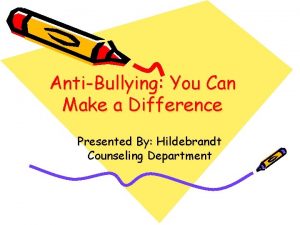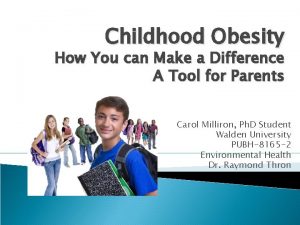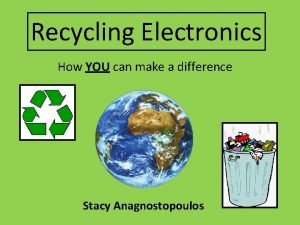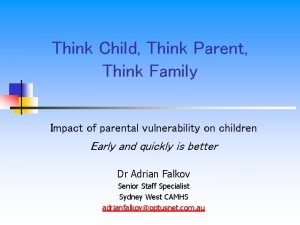So you think you can make a difference




































- Slides: 36

So you think you can make a difference! the process of assessment and developing a plan for partnerships between libraries and community based organizations for health information outreach

Your ideas n What do you want to do? n n n The Growing Demand For Health Information Providing Health Information Services Why? For whom? When?

Your resources n n What’s your expertise? What resources do you have? What resources do you need? Are you reinventing the wheel? Is anyone already doing something like this?

When do you need a partner? n n n Available expertise cannot meet a known need Available resources cannot support a needed activity/program Funding agencies require/prefer/suggest it n n n http: //nnlm. gov/libinfo/community/funding. php http: //www. imls. gov/grants/library/ http: //www. gatesfoundation. org/libraries

Potential partners for libraries n n n Local physicians, dentists, and chiropractors, pharmacies Public health departments Women, Infants, and Children (WIC) program offices Counseling centers or mental health clinics, HIV/AIDS resource centers and clinics YMCA or YWCA, Faith-based groups Planned Parenthood Public and private schools La Leche League groups Hospice providers, visiting or home healthcare nurses Senior citizens' homes, day care centers Fitness centers or health clubs Health food stores

Collaboration is… “… a mutually beneficial and well-defined relationship entered into by two or more organizations to achieve common goals. The relationship includes a commitment to mutual relationships and goals; a jointly developed structure and shared responsibility; mutual authority and accountability for success; and sharing of resources and rewards. " Collaboration: What Makes it Work (2 nd Edition) A review of Research and Literature on Factors Influencing Successful Collaboration, by Paul W. Mattessich

Who makes a good partner? n Criteria for potential partners n n Organizational atmosphere Staying power History of success Similarity of interest – common ground

Establishing the partnership n Dr. Norge Jerome, Ph. D, Professor Emerita of Preventive Medicine (Nutritional Anthropology) and Interim Associate Dean for Minority Student Affairs, University of Kansas School of Medicine http: //www. childhealthfoundation. org

Academic/community partners n Equity is a top priority in developing and sustaining partnerships n Develop a governance structure to achieve equity n n Developed by all partners/stakeholders to drive policy and operations Potential partners are unlikely to come on board if they do not believe that their voices will be heard. n Create an Advisory Board that includes at least one member of each partner n Address the health priorities of community partners from the very beginning n The campus partner then lends its expertise to address these priorities

Academic/community partners n Community capacity building, with built-in sustainability, is paramount n n n Community partners are able to carry out their work when project funds" dry up" Periodic evaluation, based on the group's strategic plan should be conducted as part of the routine operation Partnership leaders should become members of the Community-Based Public Health Caucus of the American Public Health Association

Before you begin, do an assessment to… n n Understand the partnership Describe your community and its people n n n identify the needs of a community to provide services appropriate to those needs Understand the environment Identify stakeholders

Understand the partnership n n n Write a mission statement that succinctly captures goals and concerns, yet is broad enough to allow room for growth and change Identify program's policies and procedures and train all staff in these Establish/define roles of partners, honestly recognizing the strengths of each partner. Meet regularly to enhance effective communication. Develop a relationship with the partners and their staff members; recognize the “natural leaders”

Understand the partnership n n Gain support from the top-level staff of partner organizations; give support by encouraging an exchange of ideas and information. Be responsible. The program should complement the partners' organization not add to the partners' workload. n Understand key partners' organizational cultures n Learn the rules and follow them. Find a member who can act as a "liaison" for each partner. n Develop written guidelines to ensure that agreements and protocol become standardized.

Describe your community Formal and informal methods n n Collect demographic data Conduct surveys, hold focus groups, interview key informants Attend community functions and/or meetings Observe

Understand the environment n n n Examine needs, desires and problems in context Validate assumptions about your contributions and services Provide a baseline for future evaluation

Identify stakeholders n n n Funders Board Members – yours, your funders, your target audience Partners Community Others?

Assessment Resources n n n Measuring the Difference: Guide to Planning and Evaluating Health Information Outreach The New Planning for Results New Pathways to Planning

Measuring the Difference n n n Stage 1: Conducting a Community Assessment Stage 2: Developing Goals and Objectives Stage 3: Planning Activities and Strategies Stage 4: Planning Evaluation Stage 5: Gathering Data and Assessing Results Stage 6: Utilizing and Reporting Results

NEW Planning for Results n Part One The Planning Process Part Two Public Library Service Responses Part Three Tool Kit Part Four Workforms

New Pathways to Planning

Plan your program n n n Plan vs just “jump in” Good planning is the foundation for measuring impact Create a logic model

Logic models n n Concise description of how the activities carried out within the program are related to the expected outcomes Framework for planning and evaluating programs A tool for organizing your thoughts Fluid

Elements of a logic model n n n Goals: The purpose of the program Outcomes: What benefits, changes accrue Outputs: How much of what must be produced Activities: What actions must be taken Resources: What will be needed

Goals n n n Statement of Purpose – why we do what we do and for whom Goals also help define the scope of what you can accomplish within the proposed period of time of your project Example n n We will have increased the awareness of and access to biomedical information resources for health professionals and the public. There will be collaboration in the MCR between medical and public librarians in order to more effectively provide consumer health information to the public

Outcomes n Outcomes should be n n n Goal-related Specific Measurable Action oriented Realistic Timed

Outcomes are If: then relationships n n n Often multiple desired outcomes for participants A series of outcomes, with one outcome contributing to another Hierarchy of logically related changes or benefits comprises a series of "if-then" relationships

Activities and Outputs n Activities n n n What will you do? Who will do it? Outputs n n How How many did you do? attended? were distributed? times was it used?

Resources n What you have n n n Budget or expected income Equipment Collection Staff What you need n n n Operating expenses (e. g. , personnel, acquisitions, maintenance, etc. ) Funds for new initiatives or services Space

Logic models are fluid Resources Activities Outcomes Outputs

Logic models may change over time n n n Review progress Document program changes Don’t change horses mid-stream

Plan backward Implement forward n Goals n Outcomes n Activities and Outputs n Resources

Logic model template Goal: _________________ Resources Personnel, money, expertise needed Activity What you will do Outputs What your activity will produce – data, classes, brochures, etc Outcomes The SO WHAT – the benefits that accrue as a result of your program

Example Goal: Improve diet and medication compliance of diabetes patients in North Omaha population Resources Personnel, money, expertise needed Activity What you will do Outputs What your activity will produce – data, classes, brochures, etc Diabetes Participate in Brief presentations, educators, Health citywide health fair brochures, sciences librarian, Budget for exhibit space, computer, internet connection Outcomes The SO WHAT – the benefits that accrue as a result of your program Attendees will understand what their numbers mean

Outcomes Indicators The SO WHAT – the benefits that accrue as a result of your program Measurable approximations of the desired outcome. Attendees will understand what their numbers mean 50% of teens who attended the health fair can 1 week later explain to a health educator the meaning of their glucose test numbers

Sources for more information n W. K. Kellogg Foundation Logic Model Development Guide http: //www. wkkf. org/Programming/Resource Overview. aspx? CID=281&ID=3669 Institute of Museum and Library Services http: //e-services. imls. gov/project_planning The United Way http: //national. unitedway. org/outcomes

Betsy Kelly betsy. kelly@wustl. edu 1 -800 -338 -7657
 Go make a difference we can make a difference
Go make a difference we can make a difference If you think you can you can poem
If you think you can you can poem Think big think fast think ahead
Think big think fast think ahead So you think you can argue
So you think you can argue So you think you can argue
So you think you can argue You can argue
You can argue One person can make a difference essay
One person can make a difference essay If you can imagine it you can achieve it
If you can imagine it you can achieve it If you cant measure it you cant improve it
If you cant measure it you cant improve it If you can't measure it you can't manage it
If you can't measure it you can't manage it If you cant measure it you can't manage it
If you cant measure it you can't manage it You can't manage what you can't measure bedeutung
You can't manage what you can't measure bedeutung Oh the thinks you can think quotes
Oh the thinks you can think quotes Robin and jay poem
Robin and jay poem Think fam think
Think fam think Can you make them behave king george fact and opinion
Can you make them behave king george fact and opinion Can you make predictions about tech devices
Can you make predictions about tech devices Teaching as a vocation meaning
Teaching as a vocation meaning You can number make there would
You can number make there would What conclusions can you make from examining the geochart
What conclusions can you make from examining the geochart First challenge how many words can you make
First challenge how many words can you make Origin of the olympics
Origin of the olympics How can you make the most of your resources
How can you make the most of your resources Deoxribonucleic
Deoxribonucleic How can a machine make work easier for you
How can a machine make work easier for you How can you make the girl ____ generous?
How can you make the girl ____ generous? Tripped by on rosy wings
Tripped by on rosy wings Choose the correct answer ac
Choose the correct answer ac So you think you know minecraft
So you think you know minecraft What comes to mind when you hear the word family?
What comes to mind when you hear the word family? You have more potential than you think
You have more potential than you think What makes plants grow
What makes plants grow What do you think of when you hear
What do you think of when you hear You can tell harris about it just ____(easily) as i can.
You can tell harris about it just ____(easily) as i can. You can tell harris about it just ____(easily) as i can.
You can tell harris about it just ____(easily) as i can. How to be more impressive 1+1=2
How to be more impressive 1+1=2 Through you nothing is impossible
Through you nothing is impossible
